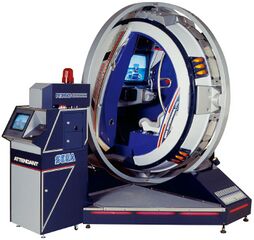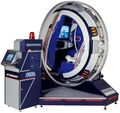Difference between revisions of "R360"
From Sega Retro
m |
|||
| Line 14: | Line 14: | ||
}} | }} | ||
}} | }} | ||
| − | The '''R360''' is a special arcade cabinet developed by [[Sega]], released in Japan in 1990. Capable of rotating 360 degrees on two axis, the cabinet simulates in-game motion, while allowing its player to assume basic control of an adapted game and the moving pod itself. Originally designed exclusively for Japan and ''[[G-LOC: Air Battle]]'', | + | The '''R360''' is a special arcade cabinet developed by [[Sega]], released in Japan in 1990. Capable of rotating 360 degrees on two axis, the cabinet simulates in-game motion, while allowing its player to assume basic control of an adapted game and the moving pod itself. Originally designed exclusively for Japan and ''[[G-LOC: Air Battle]]'', its life was extended for a 1991 worldwide release and other games.{{ref|1=https://web.archive.org/web/20210719231316/https://myemail.constantcontact.com/Stinger-Report---03-05-2021.html?soid=1103295952658&aid=YbRTe95u7yA}} |
Though ultimately an expensive commercial endeavour for Sega, the R360 has been retrospectively credited as a masterpiece of their arcade output by critics and gaming enthusiasts alike.{{ref|1=https://web.archive.org/web/20210719231316/https://myemail.constantcontact.com/Stinger-Report---03-05-2021.html?soid=1103295952658&aid=YbRTe95u7yA}} Due to the popularity of the concept, Sega has revisited the basic cabinet design for the newer ''[[Dennou Senki Virtual-On Special]]'' and ''[[Transformers Human Alliance Special]]'' in its [[Joypolis]] indoor theme parks. | Though ultimately an expensive commercial endeavour for Sega, the R360 has been retrospectively credited as a masterpiece of their arcade output by critics and gaming enthusiasts alike.{{ref|1=https://web.archive.org/web/20210719231316/https://myemail.constantcontact.com/Stinger-Report---03-05-2021.html?soid=1103295952658&aid=YbRTe95u7yA}} Due to the popularity of the concept, Sega has revisited the basic cabinet design for the newer ''[[Dennou Senki Virtual-On Special]]'' and ''[[Transformers Human Alliance Special]]'' in its [[Joypolis]] indoor theme parks. | ||
| Line 94: | Line 94: | ||
GLocR360 Arcade Cabinet.jpg|Cabinet | GLocR360 Arcade Cabinet.jpg|Cabinet | ||
R360 Hi Tech Land Sega Shibuya.jpg|[[Hi-Tech Land Sega Shibuya]], 1990 | R360 Hi Tech Land Sega Shibuya.jpg|[[Hi-Tech Land Sega Shibuya]], 1990 | ||
| − | R360 AOU Show 1991.jpg|[[ | + | R360 AOU Show 1991.jpg|[[Amusement Machine Show 1991]], ''[[Rad Mobile]]'' |
R360 Wing War 1994.jpg|1994, ''[[Wing War]]''{{magref|harmony|130|15}} | R360 Wing War 1994.jpg|1994, ''[[Wing War]]''{{magref|harmony|130|15}} | ||
Sega R360 GLOC.jpg|''G-LOC R360'' | Sega R360 GLOC.jpg|''G-LOC R360'' | ||
Revision as of 12:37, 12 October 2023

| |||||||||||||||||

| |||||||||||||||||
| R360 | |||||||||||||||||
|---|---|---|---|---|---|---|---|---|---|---|---|---|---|---|---|---|---|
| Manufacturer: Sega | |||||||||||||||||
|
The R360 is a special arcade cabinet developed by Sega, released in Japan in 1990. Capable of rotating 360 degrees on two axis, the cabinet simulates in-game motion, while allowing its player to assume basic control of an adapted game and the moving pod itself. Originally designed exclusively for Japan and G-LOC: Air Battle, its life was extended for a 1991 worldwide release and other games.[2]
Though ultimately an expensive commercial endeavour for Sega, the R360 has been retrospectively credited as a masterpiece of their arcade output by critics and gaming enthusiasts alike.[2] Due to the popularity of the concept, Sega has revisited the basic cabinet design for the newer Dennou Senki Virtual-On Special and Transformers Human Alliance Special in its Joypolis indoor theme parks.
Contents
Design
The R360 cabinet is best described as a gyroscopic motion simulator. Its complex nature means that numerous components are used on the inside and outside to ensure it performs its purpose correctly, however the most significant of these include its cockpit, wireframe, and control tower. These three parts contain the main bulk of the cabinet's hardware, either attached within or outside for the player or operator to use.
The main selling point of the R360 is, as its name may suggest, the ability to Rotate 360 degrees on any axis with a maximum of 2Gs. So in G-LOC's case, if the player causes the jet plane to perform a barrel roll, the cockpit will rotate to attempt to simulate this movement in the real world. Predictably, the immense weight of the cabinet and safety considerations means it does not respond well to quick movements.
The R360 is able to perform these movements on both the X and Y axis through its use of drive motors and slip rings. The former is made up of 1.5KW AC servo motors made by Toshiba, two for each axis.[3] To do these safely, numerous safety requirements are employed; a series of sensors and an emergency button inside the cockpit stop motion, and a unique harness seatbelt design is used for added security.
Aside from its safety measures, the cockpit also contains a 20 inch CRT monitor, joystick, handbrake, and an original bucket seat design made of FRP and urethane, covered in grey PVC leather. In the case of Wing War being installed, an added throttle control and link equipment for battle with another R360 unit will be required, whereas with Rad Mobile, a redesigned control panel and rewired brake/gas pedals are needed.
Outside of the main cockpit and wireframe is an operator control tower, containing further safety controls, a 10 inch monitor displaying gameplay, microphone terminal, and the boards for the installed game. Further components include its stereo sound system, subwoofer, exterior cockpit lighting, and fence. In total, the R360 should normally make use of a 4.5m x 4.5m installation space, with the cabinet body itself weighing 1,100kg and measuring 250cm in width, 300cm depth, and 240cm height. Due to its hefty technological demands, the R360 also requires a 3-phase power supply; 240V in the USA, 380V in Japan, and 415V in the UK.
History
- Main article: R360/History.
Games
- G-LOC: Air Battle (1990)
- Rad Mobile (1991)
- Wing War (1994)
Locations
- Hi-Tech Land Sega Shibuya[4]
- O2 Park Sega World[5]
- Sega Cineset[6]
- Carnival[7]
- Sega World Tokyo Roof[8]
- Sega World Settsu Wings[9]
- Sega World South West[10]
- Sega World Cospal[11]
- Sega Charlie One[12]
- Festival Disney[13]
- Espacio[14]
- Roppongi GiGO[15]
- Metropolis
- Sega World Bournemouth
- Sega VirtuaLand
- SegaDome Colindale
- Sega World Tamworth
- Sega World Wolverhampton
- Sega World Birmingham
- Centre Sega Amiens
- Centre Sega Paris
- Sega Park Madrid
- Sega Park Valencia
- SegaWorld London
- Sega World Sydney
Magazine articles
- Main article: R360/Magazine articles.
Promotional material
- Main article: R360/Promotional material.
Video coverage
- "Giant gyro game", Tomorrow's World (UK), S26 E17, 1991-05-02
- "Arcade center in Japan", Marafon-15 (SU), "In Japan", 1991-xx-xx, (+ 1:45)
- "Newest amusement centre in Tokyo", Bad Influence! (UK), S1 E8, 1992-12-17
Patents
Artwork
Photo gallery
External links
- Development summary at sega-mechatro.com (defunct, Segakore backup)
- Video Game Storytellers Part 19: Sega's genes, passed down to the next generation by the development team of the ultimate sensory game cabinet, R360. interview with engineers Masao Yoshimoto and Masaki Matsuno by Fumio Kurokawa at 4Gamer.net (Japanese)
References
- ↑ https://sega.jp/history/arcade/product/18204/
- ↑ 2.0 2.1 https://myemail.constantcontact.com/Stinger-Report---03-05-2021.html?soid=1103295952658&aid=YbRTe95u7yA (Wayback Machine: 2021-07-19 23:13)
- ↑ https://www.4gamer.net/games/999/G999905/20200704005/ (Wayback Machine: 2020-07-24 15:01)
- ↑ http://backup.segakore.fr/mechatro/mtv/pm/pm03.html
- ↑ File:Virtual Reality JP 1x01.mp4
- ↑ File:Sega Cineset 2F 1.jpg
- ↑ Beep! MegaDrive, "January 1991" (JP; 1990-12-08), page 32
- ↑ Beep! MegaDrive, "January 1991" (JP; 1990-12-08), page 141
- ↑ Beep! MegaDrive, "June 1991" (JP; 1991-05-08), page 128
- ↑ Beep! MegaDrive, "September 1991" (JP; 1991-08-08), page 132
- ↑ Beep! MegaDrive, "December 1991" (JP; 1991-11-08), page 130
- ↑ Beep! MegaDrive, "March 1992" (JP; 1992-02-08), page 132
- ↑ File:Festival Disney Sega 1995.mp4
- ↑ Sega Company Profile, 1992, page 7
- ↑ File:Roppongi GiGO Interior.jpg
- ↑ Harmony, "1994 8" (JP; 1994-08-01), page 15
| Mid-size attractions | |
|---|---|
| Rifle Gallery (1974) | R360 (1990) | AS-1 (1993) | Virtua Formula (1993) | Virtual Batting (1994) | Power Sled (1996) | Murder Lodge (1996) | Q-tag (1996) | Bike Athlon (1997) | Boat Race GP (1998) | Wild River (1998) | The Lost World: Jurassic Park Special (1998) | Dennou Senki Virtual-On Oratorio Tangram Special (1998) | Sky Cruising (1999) | MaxFlight VR2002 (199x) | Wild Jungle (2000) | UFO Catcher Ride (2001) | Cycraft (2003) | Wild Wing (2004) | The Quiz Show (2005) | The House of the Dead 4 Special (2006) | OutRun 2 SP SDX (2006) | Wild River Splash! (2006) | Wild Jungle Brothers (2006) | Burnout Running (200x) | Let's Go Jungle! Special (200x) | Hummer (2008) | Storm-G (2009) | Sonic Athletics (2013) | Sonic Brain Ranking (2013) | Transformers Human Alliance Special (2014) | Wild River The Treasure Hunt (2015) | Spicy Taxi (201x) | The House of the Dead Scarlet Dawn The Attraction (20xx) | |








